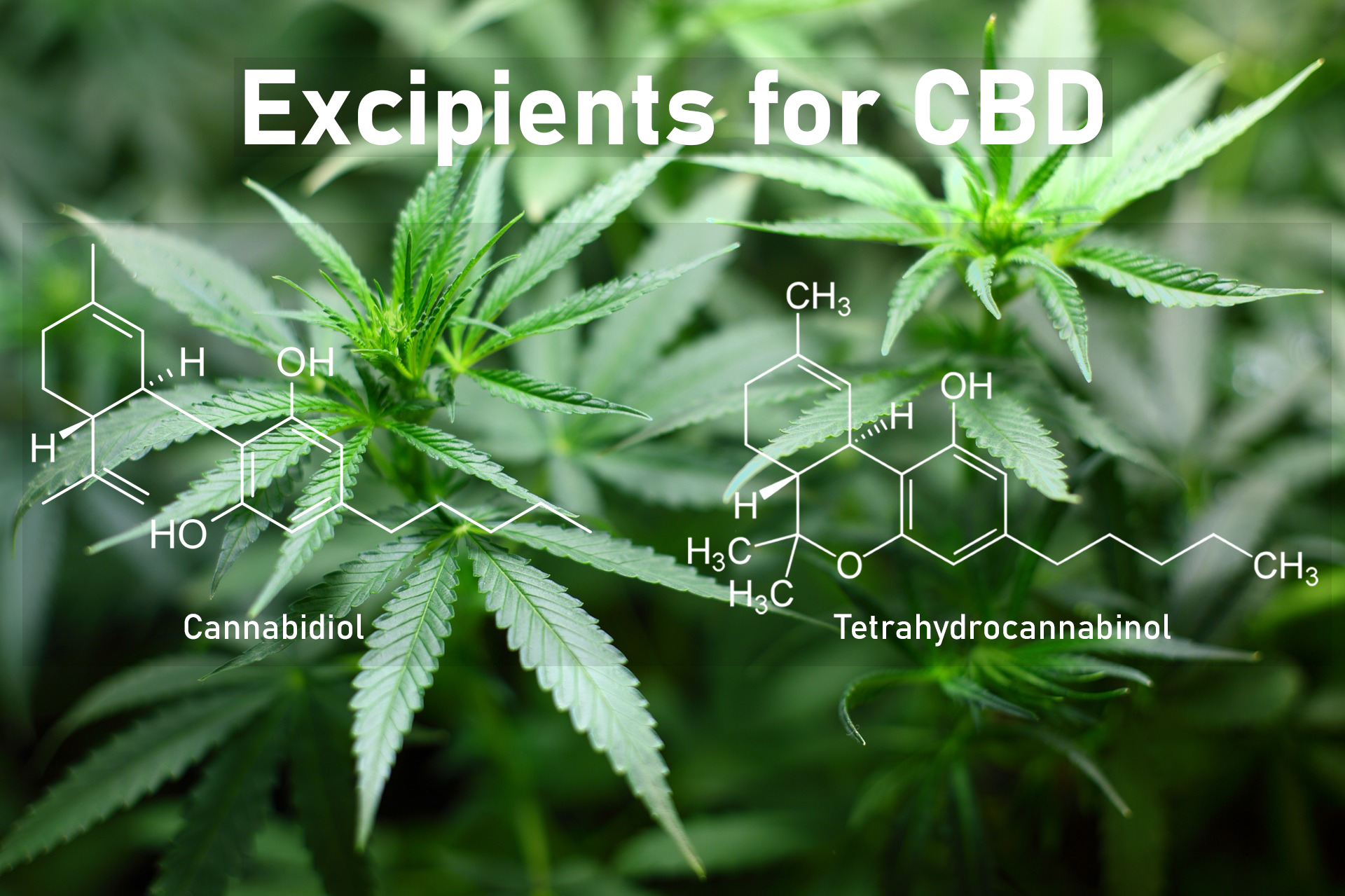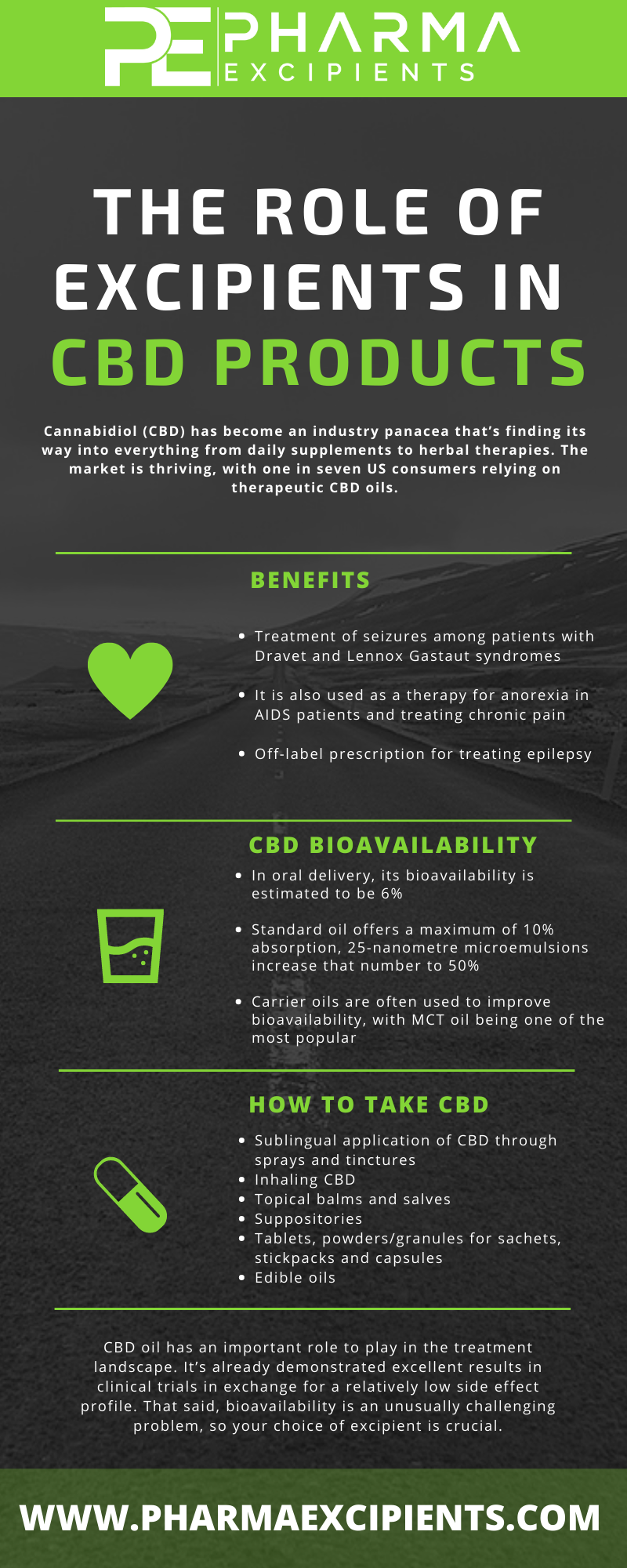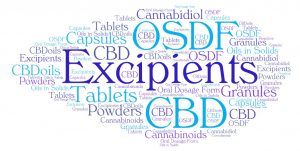The Role of Excipients in CBD Products

Cannabidiol (CBD) has become an industry panacea that’s finding its way into everything from daily supplements to herbal therapies. The market is thriving, with one in seven US consumers relying on therapeutic CBD oils. The United States spends more than $803 million a year on cannabidiol products.
Listen to the article:
The Benefits of Cannabinoids
Broadly, CBD oils are extracts made from cannabis, but cannabis is made up of more than 400 different chemicals, some of which are better studied than others. THC is cannabis’ most psychoactive and studied compound, but CBD oil products don’t always contain it. Cannabidiol extracts have been FDA-approved for the treatment of seizures among patients with Dravet and Lennox Gastaut syndromes. It’s not approved for other forms of epilepsy, but it’s often prescribed off-label for treating them.
Cannabinoids that deliver synthetic THC have performed well in clinical trials for chemotherapy-related nausea. Medical cannabis is also used as a therapy for anorexia in AIDS patients. CBD is sometimes used by Parkinson’s sufferers, but more trials are needed to establish its effects in this area. Medical science hasn’t quite reached a conclusion about its role in treating chronic pain, but it may eventually prove effective in treating movement disorders. Marijuana has been used to treat pain for centuries, but CBD’s pain-relieving effects are still poorly understood. Further human trials are needed to establish its role as an anti-inflammatory, but rat trials have been promising. CBD is often used as a treatment for anxiety and insomnia.
Because CBD oil contains so many chemicals, medical science hasn’t yet assessed every effect of every component. Many healthcare providers hope that trials will eventually prove its efficacy in treating certain cancers. As yet, trials have been inconclusive in this area. A study of 47 multiple sclerosis patients found improvements in muscle spasms, but there was no placebo to galvanise results.
Cannabinoid delivery systems play an important role in their effect. CBD Solids and oils have completely different effects, so CBD ODF is all-important.

CBD Bioavailability
The end product’s quality relies heavily on CBD’s:
- Means of extraction
- Delivery form
- Manufacturing consistency
- Excipient choices.
It can be delivered in everything from edible oils to vaping juices. In oral delivery, its bioavailability is estimated to be 6%, but THC absorbs far more easily. First-pass metabolism is to blame for that low number, but aerosolised versions are quickly distributed into the tissue, particularly the adipose layers. Cannabinoids are metabolised in the liver.
CBD oral dosage form through edibles and capsules allows it to enter the digestive system before it’s absorbed. Hemp extract needs to pass through the portal vein, then into the liver, which reduces CBD concentrations in the bloodstream. Carrier oils are often used to improve bioavailability, with MCT oil being one of the most popular. CBD-rich hemp extracts allow the body to use the cannabinoids immediately, increasing absorption. Standard oil offers a maximum of 10% absorption, while 25-nanometre microemulsions increase that number to 50%. Coconut oil has the stability and shelf life to act as excipients for CBD, but nanoemulsions can increase bioavailability in sprays, creams, and edibles.
See the excipient basics article
How do you take CBD?
- Sublingual application of CBD through sprays and tinctures could improve on bioavailability.
- Inhaling CBD exploits the permeable interior of the lungs to push absorption up, but this shortens the period of effectiveness to mere minutes.
- Topical balms and salves are generally used purely for chronic pain and spasms.
- Suppositories offer the highest and lasting biovailability numbers.
- Tablets, powders/granules for sachets, stickpacks and capsules
- Edible oils can contain higher quantities of CBD, and can deliver a predictable, reproducible drop-to-drop dose. That makes the CBD oral solid dosage form preferable to balms and vape fluids for most patients.
That makes the CBD oral solid dosage form preferable to balms and vape fluids
for most patients.
How to make CBD Tablets
CBD tablets and soft gels contain CBD isolates and excipients. The latter gives the pill or tablet more volume and helps the digestive system to process the ingredients. Excipients are usually inactive compounds, but they don’t have to be. They can also contain nutrients, herbs, or other active compounds. The primary ingredient is usually a full spectrum product containing a range of cannabinoids in addition to CBD. This includes THC, CBDA, and CBDV, which may engage the endocannabinoid system better than CBD alone. Generally, THC levels are kept to 0.3% or less. If higher levels are needed, the active ingredient can be sourced from marijuana. Capsules need a gelatin shell and can also include sorbitol and artificial colouring.

Understanding Excipients
Excipients have a crucial role to play in the safety and efficacy of your end product. They act as binders and fillers, so organic chemicals such as sugars and cellulose are often used. Magnesium stearate is one of the most common inorganic options, but, CBD oil’s poor bioavailability and oil solubility make it a poor choice.
The CBD oral dosage form relies on excipients that increase systemic exposure. CBD is fat-soluble, so the most popular excipients for CBD are lipids. Ethanol is often used as an alternative. Excipients must do these jobs:
- Create the capsule or enable tablet making
- Carry the correct amount of CBD solids
- Create synergistic effects.
The excipient of the CBD oral dosage form should also help to improve its low bioavailability numbers. Excipients aren’t always inactive compounds. Capsule excipients can range from melatonin powders to chamomile. The cosmetics and pharmaceutical industry has been benefiting from nanoemulsions for many years, and they serve CBD’s hydrophobic tendencies. These pharmaceutical-grade excipients for CBD can be substituted for liposomes and vesicles. They’re non-toxic and non-irritant, offering excellent physical stability. They have a greater surface area, so they improve bioavailability. They can also be used in a huge range of formulations, from foams and creams to sprays.
Excipients for cannabinoid solid ODF include water-soluble emulsions that have a reduced cost per dose and can even amplify efficacy. Our bodies are made of 60% water, but CBD oil naturally resists being absorbed into the bloodstream. When CBD solids are emulsified in nanoemulsions, they remain stable and disperse more easily. Oral nanoemulsions have improved the bioavailability of other compounds but have yet to be studied in CBD oral dosage form. Still, many believe the technology can offer a 50% increase in bioavailability.
Liposomes rely on similar mechanics. As water-containing structures surrounded by a water-insoluble bilayer membrane, they offer potent absorption and clinical strength. They improve intra-cellular delivery, which enhances their therapeutic effects. Their ability to function in dilutions gives them a core role in CBD manufacturing. They aid drug dispersion in the GI tract and enhance lymphatic transport while simultaneously increasing the absorption window.
Topical cannabinoid products rely just as much on lipid-based excipients. The skin’s acidic range and physiology present unique challenges that can be overcome with the right emulsifiers and solubilisers.
- Microemulsions offer just the right viscosity and permeation enhancements required to enhance absorption.
- Oily carriers and solubilisers help THC across skin layers.
- Propylene glycol and ethanol blends are one of the most stable excipients for topical delivery.
- Lipid excipients lend themselves well to mucosal delivery through nasal sprays and tinctures.
Excipients cross an enormous price range, so they play a core role in defining your brand. Wallet-friendly entry-level products require cheaper binders. Taste and scent are just as important to your choice. CBD has a strong, earthy taste that can be unpalatable. Capsules, tablets, sachets or stick packs can fix this problem with sugars and other additives used in tandem for taste masking. You may also want to cover a wide dosage range, which typically begins at 5mg and ends at 50mg. The aesthetic of your capsules, tablet or other CBD ODF is more important than you might think. It allows patients and medical practitioners to identify your product and its doses, so it must be a considered choice.
CBD oil has an important role to play in the treatment landscape. It’s already demonstrated excellent results in clinical trials in exchange for a relatively low side effect profile. That said, bioavailability is an unusually challenging problem, so your choice of excipient is crucial.
See Orocan water-soluble CBD powder here

